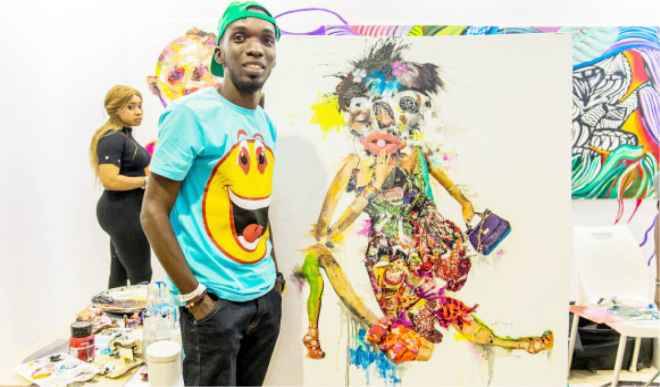
Why is your ongoing solo exhibition tagged ‘When We Are Not What We Are’?
The reason why we tagged the show ‘When We Are Not What We Are’ is because I used my life as a vocal point for creating all the work. There are times we actually wish to become some things in life, but condition and some life experiences and circumstances chase us to become who we are and what we end up becoming in life.
I would have wished to be something else, but life’s circumstances and experiences have actually chased me to become who I am today. So, my work talks about that.
What was the creative process like?
I studied art in school, and usually when you see what I am doing presently, you will notice that its different from the conventional art. The challenges I faced as an artist is one of the basic things that fuels my concept. I use car related faces and automobile related pictures. I do this because I see myself as a traveler in life, so I paint things I see, things from afar, things that are happening and those I perceive will happen in the future. This is why I use automobile related pictures.
I use collage, discarded papers and several other materials to show how things come into place to make me who I am.
Is there a trend between your present approach to art and earlier works?
Yes. Before I walked into Rele Gallery, I was doing landscape art where I depicted Lagos’ landscape, street and market life. But that was before I met Adenrele Sonariwo who made me understand that art actually has more depth than the painting of a marketplace, a woman with a child or breastfeeding her baby. She made me understand that art has gone beyond a material used to beautify a home. So, now I speak with my work and give voice to the voiceless
In 2017 you collaborated with international doll maker, Aidamaris Roman on her ‘Forgotten Heart’ series.
What led to the collaboration?
I make good use of my Instagram. I think she has been following me for a while and monitoring my progress. She just sent me a message that she will love to see my art on her doll. I agreed, she sent me some images and I made a choice. I did the work and sent it back to her.
What kind of attention did your work on Roman’s doll bring your way?
I was very happy. I have had a lot of people calling to ask for the work, but I have decided to keep it. I am keeping it for my children. I keep getting messages, but I am not selling it. I have had people offer as much as N500, 000, and it’s a very small piece.
You were listed as one of eighteen young Nigerian visual artists under thirty to follow by art critic and author, Jess Castellote. How did you feel?
I haven’t met Castellote. But he putting me on that list shows that there are other people out there who have been noticing what I do. It’s sending a message to me to take art more seriously. I have felt bad in the past that some people aren’t giving me attention, but being noticed by a respected international art critic motivates me.
Financial Times also featured you as one of Nigeria’s promising young artists…
I don’t even know how that happened. But I think they have been monitoring me, being that I make good use of my Instagram. Most of the things that have happened to me is through my use of Instagram, including my participation in Art X in Lagos. They simply sent me messages and I responded.
So, what was it like participating in Art X last year?
The Art X contest is different from the live performance. The performance involved performing live at the event. I have always worked in my studio, so it was a great experience working where there were people. It boosted my confidence and gave me more exposure. They reaching out to me was a validation that they believed I could do something good. I also got to meet many people like Emir Sanusi Lamido and Information Lai Mohammed.
You were selected as one of Rele Arts Foundation Young Contemporaries in 2017. What was the feedback like?
That was the first time I showed the ‘When We Are Not What We Are’ series. The exhibition was at the Rele gallery and a lot of people were still finding it difficult to understand what I was trying to do. The style was new and some people thought I studied outside the country because of the depth. Interestingly, what inspired the work were rejections I have had. I felt I had nothing to lose and expressed myself. I decided not to impress anyone. And this was what brought out the work. You are supposed to express yourself and not try to impress with your art.
How did art begin for you?
I come from a background where art isn’t seen as a career path. It’s seen as a profession for the poor. It’s believed that if you study it, you are going to be poor in life.
I grew up in Badagry, close to the border, so the environment itself was a challenge to me. In school I made use of all sorts of vibrant colours and some lecturers didn’t understand what I was trying to do. So, moving away from convention, I carved out what was mine instead of what the environment was comfortable with or used to. But galleries I walked into refused to accept my work. But Rele Gallery gave me a chance to showcase my work.
I have featured in some auctions. I have done a live performance at Artfest in November 2017. I have also shown my work in Canada and in an auction in the United States. Getting myself into the Nigerian art world was very challenging.
What was life like before you became a full-time artist?
I worked in the media industry for five years. I worked with TVC and Bloomberg. I was paid well but I wasn’t fulfilled. Sometimes when I go home late at night, instead of resting to prepare myself for the next day, I paint. So, it was very difficult for me, until the day I decided to leave when I was selected by Rele Arts Foundation. That was one of the things that pushed me to create those works.
When you aren’t working art what do you do?
I’m more of an indoor person, so when I am not painting I watch movies.

 Join Daily Trust WhatsApp Community For Quick Access To News and Happenings Around You.
Join Daily Trust WhatsApp Community For Quick Access To News and Happenings Around You.


